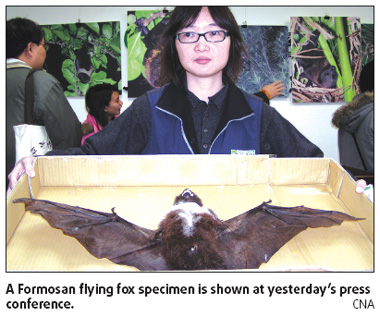Conservation zone for endangered bat
Updated: 2010-01-13 07:39
(HK Edition)
|
|||||||

TAIPEI: The Council of Agriculture (COA) said yesterday it is planning to set up a conservation zone for the Formosan flying fox, the largest of more than 30 bat species in Taiwan.
It is hoped that establishing the protection area on Gueishan Island, in northeastern Taiwan's Yilan County, will increase the population of the bats, which has drastically dwindled in recent decades, said Yen Jen-piao, director of the COA's Forestry Bureau.
Large numbers of the mammals were caught to be eaten as a delicacy and many were raised as pets during the 1970s, causing the number of wild Formosan flying foxes to drop sharply, according to Lin Hua-ching, a specialist at the Forestry Bureau. The word "bat" in Chinese has a character that is pronounced the same way as the Chinese word for happiness; and bats are considered lucky charms in traditional Chinese culture.
"Roughly after 1976, hardly any of them were seen in the wild," Lin said.
The COA has declared the Formosan flying fox a species of wildlife on the verge of extinction, in line with the Wildlife Conservation Law.
Lin and Yen were speaking at a news conference on the reemergence of the Formosan flying fox after its disappearance for more than three decades.
Three of the bats were spotted on Taiwan's outlying Green Island in 2005, according to Chen Hsiang-fan, a specialist at the TaipeiZoo, who told reporters at the news conference about the findings by a research team formed by the Forestry Bureau and Taipei Zoo.
"But as the number is only four, it faces the high possibility of disappearing due to natural disasters," Chen pointed out.
Chen said that the team again detected this type of bat in Gueishan Island in 2006.
In an intensive investigation last year, the team found the bats on the island are very active, and their number is quite stable.
Researchers said that every time they conducted nocturnal surveys, they had "fruitful findings" about the bats' various activities, including flying, hanging on trees for resting, fur grooming, food searching, and excretion.
The bats, which measure up to one meter wide with both wings fully extended, cannot make ultrasounds like other bats, and instead communicate through their cries, according to Professor Lin Liang-kong of Tonghai University.
China Daily/CNA
(HK Edition 01/13/2010 page2)